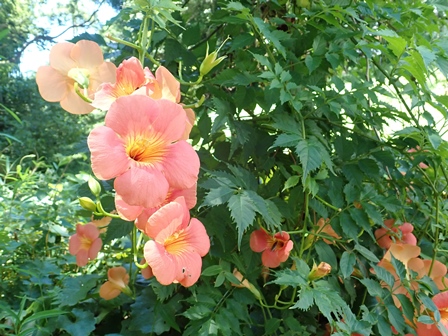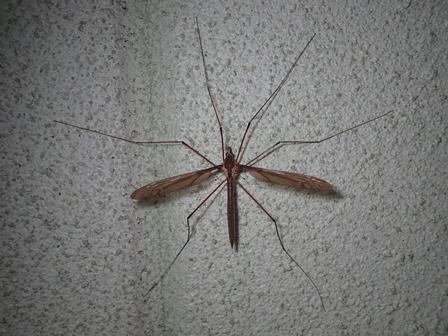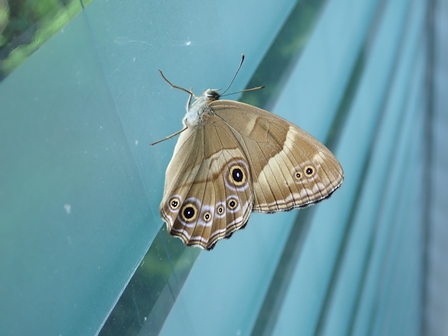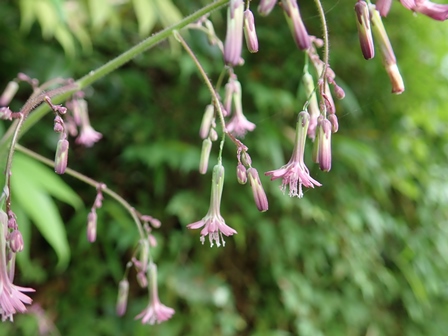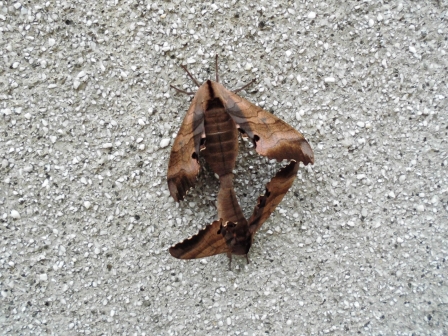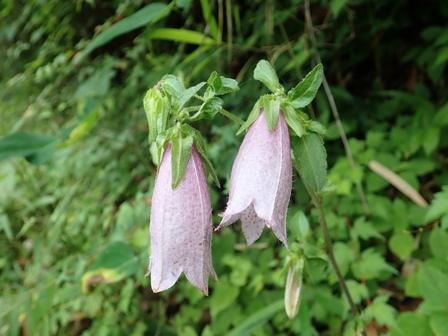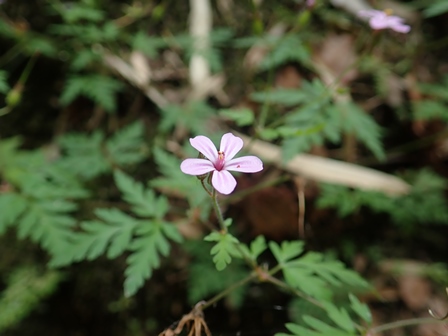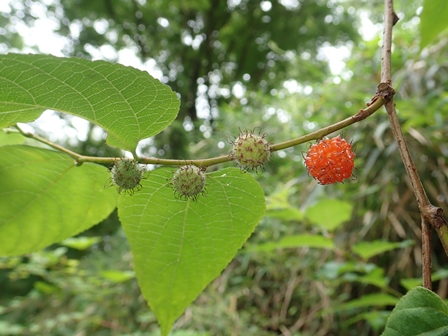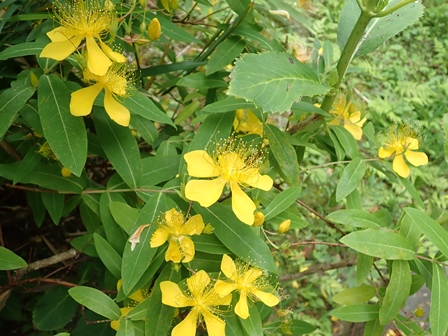フィールド日記
2021.07.20
ノウゼンカズラ
ノウゼンカズラが咲いています。中国原産で、平安時代前期に渡来したとされ、かつては薬として利用されていたようです。雌しべの柱頭は2つに分かれていて、触れると閉じるという性質があります。
"Nouzen-Kazura (ノウゼンカズラ)" trees are in bloom. They came from China more than 1000 years ago, which is the early Heian era. They were once used as a medicine at that time. The stigma of their pistil is split into two and if you touch them, they will close soon.
2021.07.16
クロツマキシャチホコ
校舎の壁にクロツマキシャチホコがとまっていました。体色や模様が枯れ枝そっくりです。幼虫はクヌギやコナラなどのブナ科の葉を食べます。
I found "Kuro-Tsumaki-Shachihoko (クロツマキシャチホコ)" on the wall of the school building. Their body colors and patterns look exactly like dead twigs. Their larvae eat oak leaves such as Konara oak trees and Kunugi oak trees.
2021.07.13
ミカドガガンボ
校舎の壁にミカドガガンボが止まっていました。蚊を大きくしたよう見た目ですが、蚊のように人の血を吸うことはありません。幼虫は水辺で生育しています。
本種は日本最大のガガンボで体長は4cmほどにもなり、長い脚まで含めると、手のひらには収まらないほどの大きさです。
I found "Mikado-Gaganbo (ミカドガガンボ)" on the wall of the school building. They look like large mosquitoes but they don't suck human blood. Their larvae live by the water. This species grow up to 4 cm in body length and it's the largest in Japan. Including their long legs, they don't fit in the palm of your hand.
2021.07.09
ヒカゲチョウ
高校校舎でヒカゲチョウを見つけました。どこからか迷い込んできたようです。雑木林周辺でよく見られる種で、不二聖心でもクヌギの樹液に集まっている様子が観察されています。幼虫の食草はササ類です。
I found a "Hikage-Chou (ヒカゲチョウ)" butterfly in the high school building. It seems to have strayed into the building. They are often seen around thickets. In Fuji-Seishin, they have been observed gathering to tree sap of the Japanese chestnut oaks. Their larvae eat Sasa plants.
2021.07.06
ムラサキニガナ
校舎の裏でムラサキニガナが咲いています。やや湿った樹林内や林縁に生育する多年草で、1mほどに成長します。名前の通り、紫色の花が下向きに咲きます。茎や葉を切ると、白い乳液が出てきます。
"Murasaki-Nigana (ムラサキニガナ)" plants are in bloom behind the school building. They are perennial plants that grow up to about 1m in height in a little moist forests and on the edge of forests. "Murasaki (ムラサキ)" in its name means "purple" and as the name suggests, their flowers are purple. Cutting the stem or leaves, you will see milky juice coming from the cut end.
2021.07.02
モモスズメ
生徒たちに大きな蛾がいますと呼ばれて行ってみると、図書館の壁にモモスズメがとまっていました。交尾中で、上がメス、下がオスです。写真では前翅の下にあって見えませんが、後翅が桃色であることが和名の由来のようです。
As students said that they had seen big moths in the library, I went there and it turned out that "Momo-suzume (モモスズメ)" moths were on the wall of the library. They were mating and the upper one was a female while the lower was a male. "Momo (モモ)" in the name means "peach" and it comes from the fact that their hind wings are pink like peaches although we can't see them in the photo because they are under fore wings here.
2021.06.29
ホタルブクロ
校舎の裏でホタルブクロが咲いています。和名は、子供たちが釣鐘型の花の中にホタルを入れて遊んだことに由来すると言われています。花の色は白から赤紫まで変異があります。花の内側には紫の斑点があり、外側からも透けて見えます。
"Hotaru-Bukuro (ホタルブクロ)" plants are in bloom behind the school building. The name comes from the fact that children used to play putting fireflies into the bell-shaped flowers. Their flowers have variety of colors from white to red-violet. There are violet spots inside the flowers that are seen through from outside.
2021.06.25
ヒメフウロ
裏道でヒメフウロが咲いていました。日本ではもともと伊吹山など限られた地域でのみ自生していますが、世界的には北半球の温帯に広く分布しています。近年、園芸用に国外から持ち込まれたものが逸出し、道端などでよく見かけるようになったようです。この個体も本来の自生ではなく、園芸品の逸出と考えられます。
"Hime-Fuuro (ヒメフウロ)" plants are in bloom on the back road. In Japan, they originally grow in limited areas like Mt.Ibuki while, globally, they widely grow in the regions of temperate climate on the Northern hemisphere. These days, those brought for gardening from abroad escape to the nature and "Hime-Fuuro (ヒメフウロ)" are often seen on roadsides. This one in the photo doesn't seem to have originally lived here but escaped from a garden.
2021.06.22
ヒメコウゾ
ヒメコウゾの果実が赤く色づいていました。この実は食用になります。ヒメコウゾの樹皮はかつて和紙の原料として用いられたそうです。
"Himekouzo (ヒメコウゾ)" fruits are turning red. They are edible. Their bark was once used to make Japanese paper.
2021.06.18
ビヨウヤナギ
聖心坂でビヨウヤナギが咲いています。中国原産で17世紀に渡来したと言われています。花が美しいため、よく庭などに植えられています。ヤナギと名前がついていますが、ヤナギの仲間ではなくオトギリソウの仲間です。
"Biyou-Yanagi (ビヨウヤナギ)" trees are in bloom in the "Seishin Zaka(聖心坂)". They came from China in 17th century. They bloom beautiful flowers so they are often planted in gardens. They are called "Yanagi (ヤナギ)", but they are not related to "Yanagi (ヤナギ)" trees. Rather, they are a close relative species to "Otogirisou (オトギリソウ)" plants.


